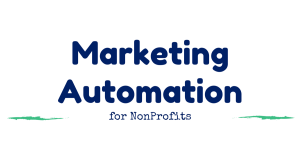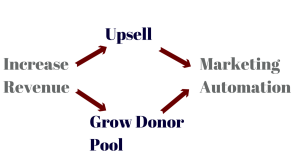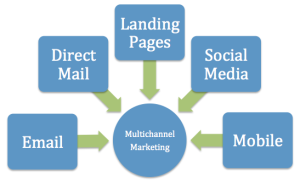Marketing Automation for Nonprofits
Drive Donations While Decreasing Costs
Nonprofits thrive or fail based on their ability to optimize activities around the same dynamic as any other organization: maximizing revenue while minimizing costs. While nonprofit revenues are derived from a variety of sources, the most successful nonprofits present thoughtful solicitations to the most receptive potential and past donors via the most efficient means. As a result, marketing automation for nonprofits has exploded recently, as organizations of all sizes seek to exploit advances in technology to quickly develop and nurture their donor bases.
Of course, this is easier said than done. Nonprofits are typically understaffed and underbudgeted, which are almost always the limiting factors for more comprehensive fundraising campaigns. But there will always be opportunities for improvement. For example, a consultant may charge an arm and a leg to suggest personnel changes or  propose alternative financial models to increase long run margins. Internal fundraising teams may outsource creative in the hopes of improving campaigns’ effectiveness. All are viable options that will likely create long-term value for the nonprofit, but these solutions involve trade offs. Each requires a significant increase in costs before seeing the revenue increase by the target amount. The solution on which this article focuses does not have that trade off: it promises to reduce long-term costs (both fixed and variable) and dramatically increase revenue. The solution, marketing automation for nonprofits, simplifies and streamlines nearly every aspect of the fundraising process, empowering marketing teams to exceed their potential. It is by far the simplest change to implement and, as an extremely low additional fixed cost in the short run, represents the greatest potential ROI.
propose alternative financial models to increase long run margins. Internal fundraising teams may outsource creative in the hopes of improving campaigns’ effectiveness. All are viable options that will likely create long-term value for the nonprofit, but these solutions involve trade offs. Each requires a significant increase in costs before seeing the revenue increase by the target amount. The solution on which this article focuses does not have that trade off: it promises to reduce long-term costs (both fixed and variable) and dramatically increase revenue. The solution, marketing automation for nonprofits, simplifies and streamlines nearly every aspect of the fundraising process, empowering marketing teams to exceed their potential. It is by far the simplest change to implement and, as an extremely low additional fixed cost in the short run, represents the greatest potential ROI.
Download our FREE Marketing Automation for Nonprofits Checklist Download Checklist
Marketing Automation for NonProfits– Why it Works
Marketing automation is the future of nonprofit marketing. It integrates a number of marketing channels (email, direct mail, landing pages, microsites, social media, etc.) into a single, easy-to-use platform, and then provides campaign analytics and the ability to personalize campaigns according to each donor’s provided information. This sounds great, but in practice how does it help? Let’s examine the specific nonprofit revenue drivers affected by marketing automation. Nonprofit fundraisers know that there are two distinct ways to increase revenue: pull larger donations from existing patrons and expand the total number of donors. Each strategy has its own difficulties and associated variable costs. This section will focus exclusively on how marketing automation improves revenue streams – the next section will deal with how it decreases costs. It is helpful to disaggregate the two in order to illustrate the true value that marketing automation for nonprofits can provide.
[Tweet “Marketing Automation for #Nonprofits – Maximize Revenue and Minimize Costs #Marketing”]
Revenue Increase:
As stated before, there are two ways to increase fundraising: “upsell” existing patrons or find additional donors. Upselling is the process of convincing one time or irregular donors to become consistent, regular donors or moving a regular donor into a higher donation tier. The upsell technique revolves around understanding a donor’s profile and appealing to spending characteristics particular to his or her demographics and interests. Since this process varies for each individual client, it is difficult to reproduce on a mass scale. As such, nonprofit marketers have tended to focus the upsell method on large, reliable donors that have an established relationship with the foundation. They simply have not had the manpower to personalize campaigns for each small donor. Marketing automation changes all that. The software’s ability to create personalized campaigns, content and incentives without the extended involvement of marketing personnel means that every donor can feasibly receive a personalized campaign geared towards increasing his or her contributions. The software uses data gathered on each individual past donor, and then automatically personalizes the content directed at those individuals. This data may be gathered from landing pages, past transactions, or simple click-through records. By optimizing the use of this information for each individual donor, marketers have the power to “upsell” every lead they have, not just the ones that are lucrative enough to warrant devoting personal attention. In this setting, marketing automation effectively maximizes the dollar per donor figure – something that every nonprofit dreams about.
In addition to the ongoing effort to improve the revenue per donor metric, nonprofit marketers must continually find new patrons to continue revenue growth. This strategy involves a completely different skill set than the upsell strategy. It requires broad appeal, cross-channel campaigns aimed at generating the most responses possible. Many nonprofits use simple email-only marketing software, and will supplement those campaigns with occasional direct mail blasts. For nonprofits strapped for cash, this may seem like the only option to expand their donor base. Marketing automation for nonprofits, however, is the rapidly emerging alternative. It allows organizations to touch prospective donors across many types of media, a method proven to get results. By allowing marketers and fundraisers to easily reach consumers across many different marketing channels, marketing automation shows enormous potential for increasing revenue.
Cost Decrease:
Budget size is always an area of primary concern to nonprofits, so any effort to cut costs without sacrificing revenue is quickly embraced. Marketing automation is extremely effective at reducing these costs, both fixed and variable.
The logic for reducing variable costs through marketing automation for nonprofits is simple. If a campaign is focusing on upselling past donors, the marginal cost of launching an additional personalized campaign with marketing automation is negligible, if not zero. Compare that to launching personalized campaigns donor-by-donor “by hand” – marketers will invest enormous amounts of their valuable (and expensive) time on each donor, skyrocketing the campaign’s variable costs. Alternatively, if a nonprofit is looking to find additional donors, the use of marketing automation software’s cross-channel marketing capabilities will reduce the marginal cost of every new lead targeted. Bundling email, direct mail, lading pages, social media marketing and more into a single automated software package inevitably makes using each individual channel less expensive than if each had been purchased separately. Thus, the variable costs of a cross-channel campaign done with marketing automation software will be far lower than those of a cross channel campaign done without it.
Fixed costs, in the long run, also decrease with the use of marketing automation. This concept revolves around the idea that software reduces time spent building and administering campaigns. Although marketing software inevitably carries with it a monthly or annual fixed cost, the cost of the hours of labor saved turn out to be far greater than the software’s price. The slight increase in the nonprofit’s technological fixed costs are more than offset by the associated reduction in labor fixed costs. In the end, it all comes down to this: the less time spent by marketing teams handling tasks that can be handled by a computer, the lower a nonprofit’s costs will be. The fixed costs per campaign decrease, marketers have more time to do what they do best and the nonprofit’s margins increase noticeably.
Marketing automation for nonprofits offers precise control of branding initiatives, content marketing campaigns and fundraising blasts
Conclusion:
Amidst these discussions of increasing margins, it is important not to lose sight of the nonprofit’s true goal: to best serve the cause or foundation it represents. How a nonprofit positions itself around its defining cause inevitably establishes its brand, whether intentional or not. Even in an examination of a nonprofit’s strategy from 30,000 feet like this, the impact marketing can make is clear. Marketing automation for nonprofits offers precise control of branding initiatives, content marketing campaigns, fundraising blasts, and more. It allows for considerable inter- and intra-campaign control, guaranteeing carefully tailored and consistent brand positioning across various segments of the donor population.
Depending on the size of the nonprofit, different marketing automation products are available. Small to medium organizations will prefer a “lightweight” marketing automation platform – software that is uncomplicated and cost effective. Nonprofit marketing agencies also tend to prefer lightweight marketing automation platforms, as they recognize that a vast majority of their clients are underbudgeted and understaffed. The larger nonprofits may find greater value in more expensive platforms that offer practically limitless analytics and campaign options. Whether large or small, all nonprofits will soon recognize marketing automation as a substantial, reliable, and fast-acting return on investment.





